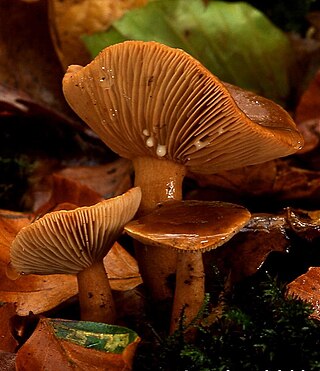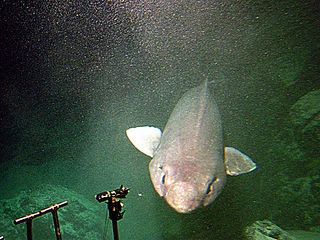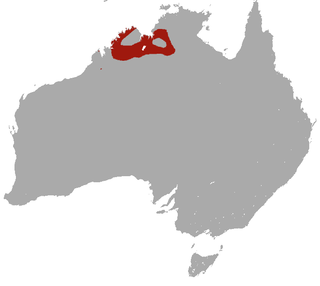
The false killer whale is a species of oceanic dolphin that is the only extant representative of the genus Pseudorca. It is found in oceans worldwide but mainly in tropical regions. It was first described in 1846 as a species of porpoise based on a skull, which was revised when the first carcasses were observed in 1861. The name "false killer whale" comes from having a skull similar to the orca, or killer whale.

The false stag beetles (Diphyllostoma) are a group of three species of rare beetles known only from California. Almost nothing is known of their life history beyond that the adults are diurnal and females are flightless; larvae have not been observed.

In mycology, a lamella, or gill, is a papery hymenophore rib under the cap of some mushroom species, most often agarics. The gills are used by the mushrooms as a means of spore dispersal, and are important for species identification. The attachment of the gills to the stem is classified based on the shape of the gills when viewed from the side, while color, crowding and the shape of individual gills can also be important features. Additionally, gills can have distinctive microscopic or macroscopic features. For instance, Lactarius species typically seep latex from their gills.

The false gharial, also known by the names Malayan gharial, Sunda gharial and tomistoma, is a freshwater crocodilian of the family Gavialidae native to Peninsular Malaysia, Borneo, Sumatra and Java. It is listed as Endangered on the IUCN Red List, as the global population is estimated at around 2,500 to 10,000 mature individuals.

The Tenebrionoidea are a very large and diverse superfamily of beetles. It generally corresponds to the Heteromera of earlier authors.
The false potto is a lorisoid primate of uncertain taxonomic status found in Africa. Anthropologist Jeffrey H. Schwartz named it in 1996 as the only species of the genus Pseudopotto on the basis of two specimens that had previously been identified as a potto (Perodicticus). The precise provenances of the two specimens are uncertain, but at least one may have come from Cameroon. Schwartz thought the false potto could even represent a separate family, but other researchers have argued that the supposed distinguishing features of the animal do not actually distinguish it from the potto; specifically, the false potto shares several features with the West African potto.

The family Oedemeridae is a cosmopolitan group of beetles commonly known as false blister beetles, though some recent authors have coined the name pollen-feeding beetles. There are some 100 genera and 1,500 species in the family, mostly associated with rotting wood as larvae, though adults are quite common on flowers. The family was erected by Pierre André Latreille in 1810.

Sea snail is a common name for slow-moving marine gastropod molluscs, usually with visible external shells, such as whelk or abalone. They share the taxonomic class Gastropoda with slugs, which are distinguished from snails primarily by the absence of a visible shell.

The false catshark or sofa shark is a species of ground shark in the family Pseudotriakidae, and the sole member of its genus. It has a worldwide distribution, and has most commonly been recorded close to the bottom over continental and insular slopes, at depths of 500–1,400 m (1,600–4,600 ft). Reaching 3.0 m (9.8 ft) in length, this heavy-bodied shark can be readily identified by its elongated, keel-like first dorsal fin. It has long, narrow eyes and a large mouth filled with numerous tiny teeth. It is usually dark brown in color, though a few are light gray.

The Alexandria false antechinus, also known as the Carpentarian false antechinus or Carpentarian pseudantechinus, is a small carnivorous marsupial, found only in a number of small, isolated localities in northern Australia. It is the smallest and rarest of the false antechinuses.

The Ningbing false antechinus, also known as the Ningbing pseudantechinus, is a small species of carnivorous marsupial found in north-western Australia. It is locally common throughout the Kimberley region of Western Australia and the Northern Territory.

Rory Cooper's false antechinus, also known as the tan false antechinus and the tan pseudantechinus, is a recently named species of small carnivorous marsupial which inhabits rocky outcrops in Western Australia. Nothing is known of its behaviour but it is expected that this will be similar to other members of the false antechinus genus. A study published in 2017 found no support for separation as a new species of Pseudantechinus, and the name was proposed to be synonymous with the previously described Pseudantechinus macdonnellensis.

Paint Creek State Park is a 5,652-acre (2,287 ha) public recreation area located in Highland and Ross counties in the U.S. state of Ohio. The state park's central feature is a reservoir, 1,148-acre (465 ha) Paint Creek Lake, which was created by the damming of Paint Creek. Construction on the dam started in 1967, and Paint Creek State Park was opened in 1972.

Xeromys myoides, also known as the water mouse, marine mouse, mangrove mouse, false water rat, manngay and yirrkoo, is a species of rodent native to waterways of Australia and Papua New Guinea.

Hesperoptenus is a genus of bats within the Vespertilionidae or vesper bat family.

Bolandra californica is a species of flowering plant in the saxifrage family, known by the common names Sierra bolandra and Sierra false coolwort. It is one of two species in the small genus Bolandra. It is endemic to the High Sierra Nevada of California, where it is an uncommon member of the coniferous forest understory.
B. californica may refer to:
Boykinia intermedia is a plant species native to northwestern Oregon and Washington. Some publications reported the species from northern Idaho as well, but these citations appear to have been based in misidentified specimens. The species grows in forests, on stream banks and lake sides at elevations up to 700 m.

Sullivantia, commonly called coolwort, is a genus of flowering plants in the saxifrage family. It is a small genus, comprising only 3-4 species of perennial herbs all native to the northwestern and east-central United States. Sullivantia is most notable for having disjunct distributions primarily restricted to along the Pleistocene glacial margin. All species of Sullivantia are found on moist, often calcareous cliffs.
Coolwort or cool-wort can refer to a number of plants including:
















